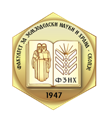CHEMICAL COMPOSITIONS AND ANTIBACTERIAL ACTIVITIES OF ESSENTIAL OILS OF FIVE AROMATIC PLANTS AGAINST PLANT PATHOGENIC BACTERIAL DISEASE AGENTS
Keywords:
Antibacterial, essential oil, Pectobacterium carotovorum subsp. carotovorum, Pseudomonas syringae pv. phaseolicola.Abstract
In this present study, the antibacterial activity and the chemical composition of essential oils from five aromatic plants (Helichrysum italicum, Inula graveolens, Cistus creticus, Echinacea purpurea and Hypericum perforatum) growing in Hatay Province of Turkey were determined. The antibacterial activity of essential oils was tested by disc diffusion method against two different economically important plant bacterial disease agents such as bean halo blight disease agent Pseudomonas syringae pv. phaseolicola and potato soft rot disease agent Pectobacterium carotovorum subsp. carotovorum. The essential oils of five aromatic plants were analyzed by gas chromatography/mass spectrometry (GC/MS). According to GC-MS analysis, 50 components were identified in H. italicum, 42 components in I. graveolens, 48 components in C. creticus, 40 components in E. purpurea and 44 components in H. perforatum. Following GC-MS analysis, neryl acetate (27.17%) and α-pinene (12.3%) in H. italicum, fenchyl (bornyl) acetate (50.33%) and borneol (36.95%) in I. graveolens, α-pinene (19.44%) in C. creticus, caryophyllene oxide (16.94%), α-pinene (16.54%) and carvacrol (6.53%) in E. purpurea and α-pinene (32.15%) in H. perforatum were determined as main components. Based on inhibition zone, the highest antibacterial activities were displayed by H. italicum and H. perforatum EOs against P. syringae pv. phaseolicola (19.33-12.33 mm), respectively. The highest antibacterial activities against P. carotovorum subsp. carotovorum was shown by H. perforatum EO (14.33 mm) followed by C. creticus (10.67 mm) EO. Based on our results, the essential oil of aromatic plants collected from Hatay province has the potential to be applied against important plant bacterial disease agents.



